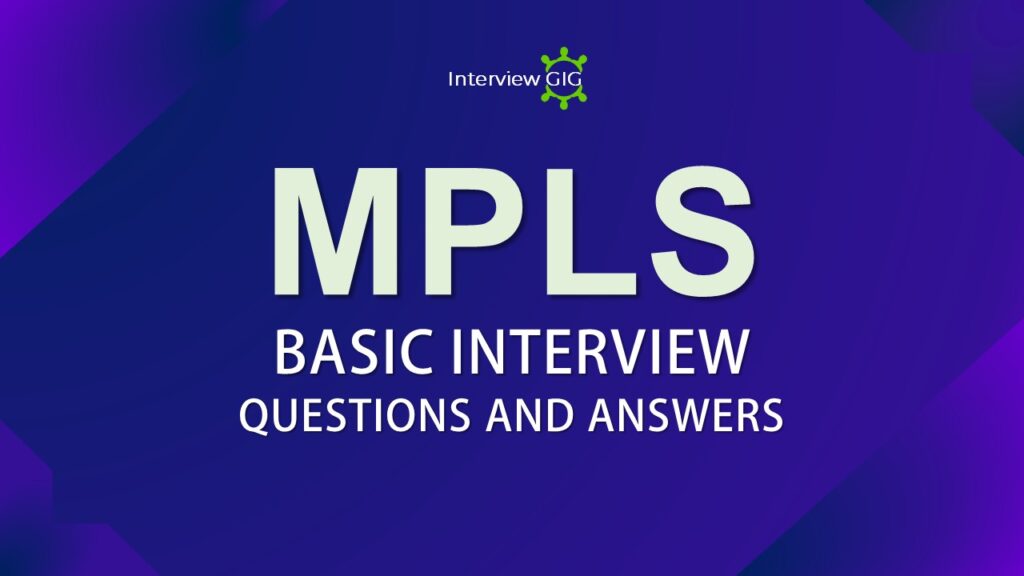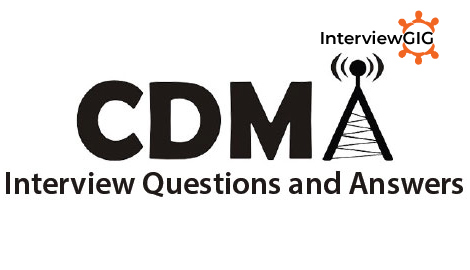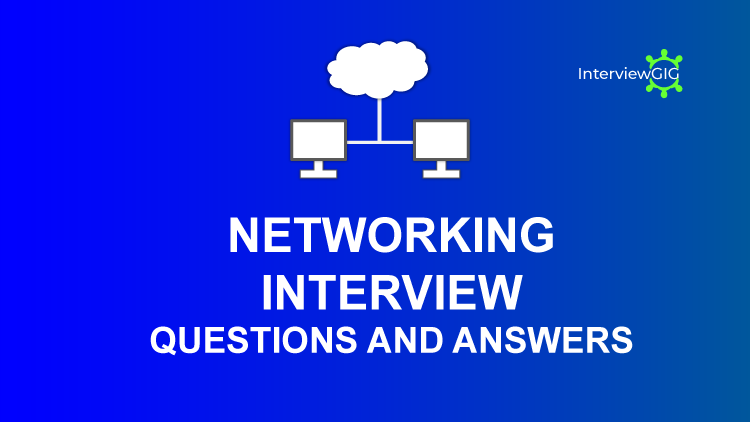What is a BGP?
BGP stands for Border Gateway Protocol. It is an inter autonomous system routing protocol. BGP is used for the large networks and normally used for connecting different ISPs. It is the protocol used between Internet service providers (ISPs) and also can be used between an Enterprise and an ISP. BGP is mainly used to connect a local network to an external network to gain access to the Internet or to connect to other organizations. The current version of BGP is BGP version 4 (BGPv4), based on RFC4271.The main use of BGP-4 are classless inter-domain routing and aggregate routes.
What is a Poison Reverse?
Poison reverse is a method used in RIP. where the gateway node communicates its neighbour gateways that one of the gateways is no longer connected.
Can you explain, how to check BGP status?
For Check BGP status-To view the BGP configuration, enter show config in CONFIGURATION ROUTER BGP mode. To view the BGP status, use the show IP BGP summary command in EXEC Privilege mode.
Can you explain how BGP works?
A BGP router receives information from its peer routers that have been defined as neighbours. BGP routers listen for updates from these configured neighbouring routers on TCP port 179.
A BGP router is a finite state machine with six various states for each connection. As two BGP routers discover each other, and establish a connection they go from the idle state, through the various states until they reach the established state. An error can cause the connection to be dropped and the state of the router to be reset to either active or idle. These errors can be caused by: TCP port 179 not being open, a random TCP port above port 1023 not being open, the peer address being incorrect, or the AS number being incorrect.
What are peers?
Any two routers that have formed a TCP connection in order to exchange BGP routing information are called peers, they are also called neighbours.
What TCP port does BGP use?
BGP uses TCP Port Number 179.
What is the use of Route Map?
route map is a method used to control and modify routing information.
Can you explain the order of preference in BGP?
The order of preference varies based on whether the attributes are applied for inbound updates or outbound updates.
For inbound updates the order of preference is:
- Route-map
- Filter-list
- Prefix-list, distribute-list
For outbound updates the order of preference is:
- Filter-list
- Route-map | unsuppress-map
- Advertise-map (conditional-advertisement)
- Prefix-list|distribute-list
ORF prefix-list (a prefix-list the neighbor sends us)
What are the some BGP Attributes?
- As-Path
- Next-Hop
- Origin
- Aggregator
- Local_Preference
- Multi-Exit Discriminator
- Weight
- Router Id
- Neighbour Ip Address
- Community
- Well-Known Discretionary
- Atomic Aggregate
- Optional Transitive
- Optional Non-Transitive
- Originator Id
- Cluster List
List the default administrative distance for BGP Routes?
Following are the default administrative distance for BGP Routes:
- Connected-0
- Static-1
- External Border Gateway Protocol route-20
- Open Shortest Path First-110
- Routing Information Protocol (RIP)-120
- Exterior Gateway Protocol (EGP) -140
- On Demand Routing (ODR)-160
- External EIGRP route-170
- Internal Border Gateway Protocol route-200
- Unknown-255
Can you explain BGP 4-byte ASN?
BGP ASN (Autonomous System Number) is a 2-byte entity. 2-bytes give 65536 possible numbers, of which, 0, 23456, 65535 and 64512- 65534 (private ASN) are reserved by IANA (Internet Assigned Number Authority). Of the remaining, 39000+ ASNs are already used. Other one is RFC 4893.It is the 4-byte ASN. 4-bytes provide ASNs ranging from 0 to 4294967296. Here, first 0-65535 are called mappable-ASN.
There are 3 different ways to write down these new 4-byte AS numbers
Asplain : It is a decimal representation of the ASN. For example, For example, AS number 545445, 7294937295, 2254967294, 9294967295, etc. -ASN 7887 will be represented as 7887, while 123456 will be represented as 123456.
Asdot+: It breaks the number up in two 16-bit values as low-order value and high-order value, separated by a dot. All the 2-byte ASNs can be represented in the low-order value.
For example: AS 65535 will be 0.65535, 65536 will be 1.0, 65537 will be 1.1, 65538 will be 1.2 and so on. The last AS 4294967296 will be 65535.65535.
Asdot – It is a mixture of asplain and asdot+. Asdot represents AS numbers less than 65536 using the asplain notation and AS numbers above 65536 with the asdot+ notation.
For example: 65535 will be 65535 while 65536 will be 1.0. Cisco uses this form of implementation.
What are BGP Neighbour States?
BGP forms a TCP session with neighbour routers called peers. BGP uses the Finite State Machine (FSM) to maintain a table of all BGP peers and their operational status. The BGP session may report in the following states:
- Idle
- Connect
- Active
- Open sent
- Open confirm
- Established
What are the BGP Message Types?
- Open
- Update
- Keepalive
- Notification
Can I use BGP instead of any IGP?
What are the different types of Autonomous Systems?
There are three different kinds of Autonomous Systems:
A multi-homed AS connects to two or more ASes so it can maintain its Internet connection should one AS connection fail.
A stub AS connects to only one other AS, though it may have its own private connections not visible to the rest of the Internet.
A transit AS acts as a link between two or more other ASes, allowing for data to pass through it, even data from unassociated networks. ISPs, for example, offer their customers and their customers’ networks access to other networks and the Internet via transit AS.
What are the different routing protocols?
Router protocols include:
RIP-Routing Information Protocol
IGP-Interior Gateway Protocol
OSPF-Open Shortest Path First
EGP-Exterior Gateway Protocol
EIGRP-Enhanced Interior Gateway Routing Protocol
BGP-Border Gateway Protocol
IS-IS-Intermediate System-to-Intermediate System
What is Route Reflector?
Routing Reflector is Network Routing Component. It is one of the ways to eliminate the full mesh of IBGP peers in the network. The route reflector allows all IBGP speakers in the autonomous system to understand the available routes without creating a loop.
What are the External and Internal BGPs?
BGP supports two types of exchanges of routing information EBGP and IBGP-
External BGP (EBGP) sessions occur between routers in different ASs which are usually next to each other sharing the same media and subnet.
Internal BGP (IBGP) sessions occur between routers within the same AS and these sessions are used to synchronise the routing policy within an AS.
What is BGP OpenSent state?
In this state BGP waits for an OPEN message from its peer. When an OPEN message is received, all fields are checked for correctness. If the initial BGP header checking detects an error, BGP deallocates all resources associated with this peer and returns to the BGP Active state. Otherwise, the Link Type, Authentication Code, and Authentication Data fields are checked for correctness.
Can you explain Why BGP is preferred over OSPF?
BGP (Border Gateway Protocol) offers more flexibility and more control to the creators and owners of a device than OSPF. BGP processes include options on what routes should be advertised and which notifications will be accepted by the device. It offers more control over route selection. This enables more flexibility to avoid overloading on particular links, which OSPF would automatically assume to provide the fastest route.
What is EGP?
EGP stands for Exterior Gateway Protocol. Its one of the protocols that is used to exchange data between gateway hosts that neighbour each other within autonomous systems.
What is EIGRP?
Enhanced Interior Gateway Routing Protocol or EIGRP is a distance vector routing protocol that is used for IP, AppleTalk, and NetWare networks
What is IGRP?
IGRP stands for Interior Gateway Routing protocol. It was developed by Cisco to address the issues associated with routing in large, heterogeneous networks.
What is Keepalive?
It is used to keep the BGP neighbour relationship to detect the inactive neighbours. Keepalive messages consist of only the packet header (19 octets in length). If the frequency of sending keepalive messages is set to 0, messages are not sent.
What are examples of IGPs?
Examples of IGPs are
RIP
EIGRP
OSPF
IS-IS
What is IS-IS?
IS-IS stands for Intermediate System to Intermediate System. It is a protocol developed by the ISO as part of the OSI protocol stack and used to manage routing within Connectionless Network Protocol (CLNP) networks. Integrated IS-IS is a derivation of the original IS-IS which was developed to support the IP protocol. As a link-state routing protocol, IS-IS has the same basic features as OSPF, including link state advertisement where link state information is sent out across the network, allowing routers to maintain a current picture of network topology. Variable length subnet masking (VLSM) is also supported.
What is the default BGP keepalive and hold down timer?
By default, keepalive timer is 60 seconds and hold-down timer is 3xkeepalive or 180seconds.
Can you explain, how to configure BGP with the use of a loopback address?
The use of a loopback interface ensures that the neighbour stays up and is not affected by malfunctioning hardware. It uses the IP address configured on the physical interface directly connected to the BGP peer as the source address when it establishes the BGP peering session,
by default. Issue the neighbour <ip address> update-source <interface> command in order to change this behaviour and configure the BGP that speaks to the router to establish peering with the use of a loopback address as the source address.
What are IGPs and EGPs?
IGPs are routing protocols that exchange routing information with other routers within a single autonomous system (AS). An AS is defined as one network or a collection of networks under the control of one enterprise.
EGPs are routing protocols that are used to transfer routing information between routers in different autonomous systems. These protocols are more complex and BGP is the only EGP protocol that you’re likely to encounter.
What is RIP?
RIP stands for Routing Information Protocol. It is most used routing protocol on internal networks. RIP is a distance-vector routing protocol that uses a hop count as its routing metric. If there are multiple paths to a destination, RIP chooses the path with the lowest hop count.
What is DUAL?
DUAL stand for Diffusing Update Algorithm. EIGRP uses the DUAL for determining the best routes to a destination. It supports classless routing. Therefore, EIGRP will include subnet mask information in routing updates. This allows for variable-length subnet mask (VLSM) and the use of discontinuous networks.





